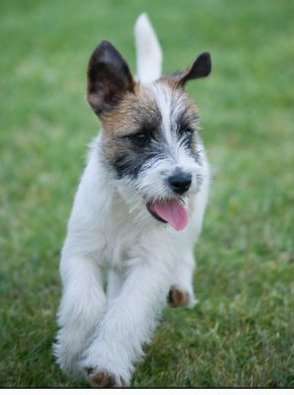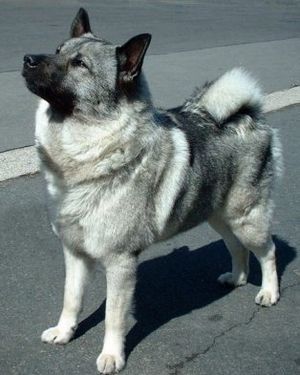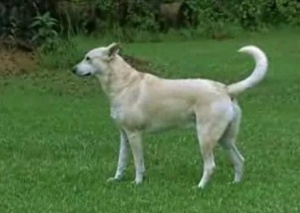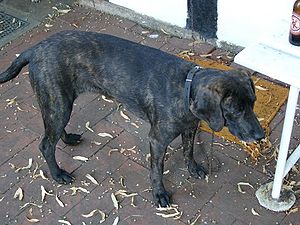 |
| Vital Statistics: |
| Place of Origin: England |
| Group: Terrier |
| Height: 10-15 in. |
| Weight: 14-18 lbs. |
| Life span: 12-14 yrs. |
| Trainability: high |
| Good with children: yes with gentle children |
| Good with other pets: may chase small animals |
What is the origin of the Jack Russell Terrier?
In the 19th century, the Reverend John Russell , a British clergyman, wanted terriers possessing speed and tenacity for hunting foxes, being able to hunt under the ground. He proceeded to breed them mainly from the Wire-haired Fox Terrier and produced the Jack Russell Terrier. In the United States, this terrier is known as the Russell Terrier, dropping the Jack.
What does the Jack Russell Terrier look like?
The Jack Russell has a strong, straight body. Height is 10-15 inches, weight about 14 -18 lbs. The nose and lips are black. Ears are small, v-shaped and fall forward, close to the head. Chest is oval-shaped. Eyes are almond-shaped and dark brown. The tail is set high and docked to about 5 inches. There are two varieties of coat, short and smooth or longer and woolly. Color is white with black, tan or black and tan markings. The coat needs brushing regularly.
What is the temperament of the Jack Russell Terrier?
The Jack Russell is a lively, active, highly intelligent little dog. This dog requires lots of exercise and an owner willing to devote the time to meeting its needs. If they don’t have enough mental and physical stimulation, Jack Russells will get into mischief. The Jack Russell needs early and constant socialization to avoid aggressiveness with people or other dogs. Children should be taught to be gentle with this dog. Because they are hunters, they may see small animals and other pets as prey. The Jack Russell is happier with lots of space due to their high energy and need for lots of activity.
What are the uses of the Jack Russell Terrier?
The Jack Russell was bred to hunt fox and vermin, digging into their dens and flushing them out. Their willingness to learn and because they are easily trained, Jack Russells excel in agility and obedience trials, flyball and Frisbee and they can be taught tricks. They are very affectionate with their family.
Possible Health Issues
Glaucoma, progressive retinal atrophy, cataracts, congenital deafness, patellar luxation.
- Airedale Terrier
- American Pit Bull Terrier
- American Stratfordshire Terrier
- Australian Terrier
- Bedlington Terrier
- Black Russian Terrier
- Border Terrier
- Boston Terrier
- Bull Terrier
- Cairn Terrier
- Cesky Terrier
- Dandie Dinmont Terrier
- English Toy Terrier
- Glen of Imaal Terrier
- Irish Terrier
- Lakeland Terrier
- Manchester Terrier
- Miniature Schnauzer
- Moscow Toy Terrier
- Norfolk Terrier and Norwich Terrier
- Old English Terrier
- Scottish Terrier
- Silky Terrier
- Skye Terrier
- Smooth and Wire-haired Fox Terrier
- Soft-coated Wheaten Terrier
- Tibetan Terrier
- Toy Fox Terrier
- Welsh Terrier
- West Highland White Terrier
- Wire Fox Terrier
- Yorkshire Terrier
- Airedale Terrier
- Beagle
- Bedlington Terrier
- Bluetick Coonhound
- Border Collie
- Border Terrier
- Bull Terrier
- Bulldog
- Bullmastiff
- Ca de Bou
- Cavalier King Charles Spaniel
- Clumber Spaniel
- Collie
- Curly-coated Retriever
- Dandie Dinmont Terrier
- English Cocker Spaniel
- English Foxhound
- English Setter
- English Springer Spaniel
- English Toy Terrier
- Flat-coated Retriever
- Golden Retriever
- Greyhound
- Harrier
- Lakeland Terrier
- Lancashire Heeler
- Llewellyn Setter
- Manchester Terrier
- Mastiff
- Norfolk Terrier and Norwich Terrier
- Old English Sheepdog
- Old English Terrier
- Otterhound
- Parson Russell Terrier
- Shetland Sheepdog
- Smooth and Wire-haired Fox Terrier
- Sussex Spaniel
- Welsh Terrier
- Whippet
- Wire Fox Terrier
- Yorkshire Terrier



